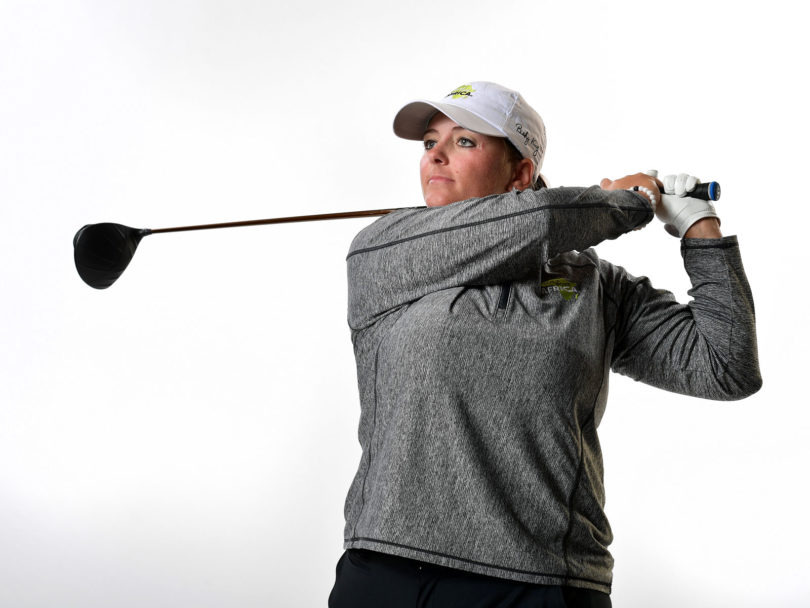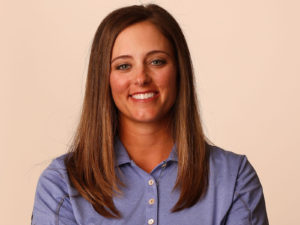Golfer Kendall Dye has always made the most of her Italian heritage, getting a golden tan every year. Even before she spent hours under the sun golfing, she’d spend time tanning outside and in tanning beds.
But as Dye participates in the LPGA Kingsmill Championship May 14-20 in Williamsburg, Va., she’ll be covered in sunscreen, wearing a hat and sunglasses. Her history with UV light caught up with her.
A Suspicious Bump and a Biopsy
In 2015, at a scheduled dermatology appointment, she had a small bump just under her left eye frozen off. By 2017, the bump was back in a different shape and different color. Dye sought out the best dermatologist near her home in Tampa to biopsy the area and check for abnormal cells.
Three weeks later, as she was driving across Nebraska, her doctor called with the news: she had skin cancer. “I’m dark-skinned,” Dye says. “I took that for granted, and then boom, I’m 30, and I have skin cancer.”
Dye was diagnosed with basal cell skin cancer, a common cancer that affects more than 4 million Americans every year. Luckily, basal cell cancer is unlikely to spread and causes fewer than 2,000 deaths per year. Dye’s dermatologist said she could finish out the 2017 season and have surgery to remove the cancer in January 2018.
Dye underwent an advanced procedure called a MOHS surgery. In this procedure, the doctor removes a thin layer of skin, then examines it under a microscope to check for the presence of cancer cells. If there are cancer cells, another thin layer of skin is removed until no cancerous cells remain. The goal of the procedure is to remove all skin cancer while leaving as much healthy skin as possible. Unfortunately, in Dye’s case, the doctor had to go deeper and wider with the skin removal than she expected, leaving a large gaping hole in her face.
The day after the MOHS surgery, Dye went to a plastic surgeon to help close the hole and restore her face to its normal appearance. The surgeon had to make the incision wider, cutting toward her nose and up around her eye to ensure the hole was closed without changing her eye shape.
Beforehand, Dye didn’t worry about either of her surgeries. She had plans to go to the Bahamas and participate in golf tournaments the very same week. But when she woke up from surgery, she knew all of that would have to change — to help her heal, her left eye had to be stitched shut.
“As athletes, we think we can do any and everything,” Dye says. “I’ve played through a broken foot. I’ve always been able to play through injury, but not this time. It knocked me on my butt.”
Without the use of her left eye, Dye felt dizzy and nauseous. She had to cancel her participation in golf tournaments and workshops for weeks. As her face healed, she also had problems facing herself or letting other see her.
“I couldn’t look in the mirror,” Dye recalls. “I saw ugly in the mirror. I saw scary in the mirror. I never had these issues before.”
Spreading Skin Cancer Awareness
Over the next few weeks, her face healed nicely, and Dye was able to use her left eye again. Though her doctor wanted her to take six weeks off, she got back onto the course a little earlier to prepare for the 2018 season. A former University of Oklahoma player, Dye last year had five top-10 finishes on the Symetra Tour, including her second career win at the Four Winds Invitational. Her rookie year on the LPGA tour was in 2015.
After her skin-cancer experience, Dye shared her story on her blog and Instagram. She now encourages everyone to see a dermatologist regularly.
“I hope that everyone, no matter whatever your genes are, will get a full-body skin check every year,” Dye says. “Even if you work indoors, you just never know. You can get sun exposure and skin cancer just driving in your car.”
Dye, now 31, will have regular check-ups for the rest of her life and is likely to have other experiences with basal cell carcinoma. Though she is taking steps to protect her skin, she admits that it’s hard to fully adjust her habits to protect against the sun.
“I probably should be wearing a wide-brimmed hat,” Dye says, “but athletes are weird about routine, and I’m not used to it. I am using a lot more sunscreen on my face and putting it on my body a lot more as well.”
Dye and nearly 150 of the top female golfers from 28 countries will play the popular Kingsmill River Course during the championship, which is in its 15thyear. To see Dye and her fellow golfers in action, you can purchase tickets online or at the gate. Visit thekingsmillchampionship.com for more information.








